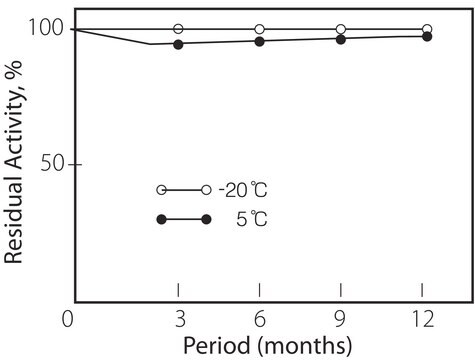I4504
Invertase from baker′s yeast (S. cerevisiae)
Grade VII, ≥300 units/mg solid
Synonym(s):
β-D-Fructofuranosidase, β-D-Fructofuranoside fructohydrolase, Saccharase
Sign Into View Organizational & Contract Pricing
All Photos(3)
About This Item
Recommended Products
biological source
bakers yeast
type
Grade VII
form
solid
specific activity
≥300 units/mg solid
foreign activity
α-galactosidase (melibiase) ≤0.01%
storage temp.
−20°C
Looking for similar products? Visit Product Comparison Guide
Application
Used in the production of confectionary foods and artificial honey.
Biochem/physiol Actions
Invertase hydrolyzes sucrose into glucose and fructose yielding a colorless product, unlike acid hydrolysis which produces colored products.
Unit Definition
One unit will hydrolyze 1.0 μmole of sucrose to invert sugar per min at pH 4.5 at 55°C.
Signal Word
Danger
Hazard Statements
Precautionary Statements
Hazard Classifications
Resp. Sens. 1
Storage Class Code
10 - Combustible liquids
WGK
WGK 3
Personal Protective Equipment
dust mask type N95 (US), Eyeshields, Gloves
Certificates of Analysis (COA)
Search for Certificates of Analysis (COA) by entering the products Lot/Batch Number. Lot and Batch Numbers can be found on a product’s label following the words ‘Lot’ or ‘Batch’.
Already Own This Product?
Find documentation for the products that you have recently purchased in the Document Library.
Customers Also Viewed
Tatiana Q Aguiar et al.
Molecular biotechnology, 56(6), 524-534 (2014-01-24)
The repertoire of hydrolytic enzymes natively secreted by the filamentous fungus Ashbya (Eremothecium) gossypii has been poorly explored. Here, an invertase secreted by this flavinogenic fungus was for the first time molecularly and functionally characterized. Invertase activity was detected in
Bryan J Leong et al.
Science advances, 5(4), eaaw3754-eaaw3754 (2019-04-30)
Plants produce a myriad of taxonomically restricted specialized metabolites. This diversity-and our ability to correlate genotype with phenotype-makes the evolution of these ecologically and medicinally important compounds interesting and experimentally tractable. Trichomes of tomato and other nightshade family plants produce
Ngoc Thi Le Nguyen et al.
Food science & nutrition, 9(2), 781-793 (2021-02-19)
This study aimed to discover whether using maltogenic amylase (MAse) to modify starch in germinated brown rice flour may enhance slow digestion starch and release more bioactive compounds (BCs) content. To achieve this aim, the starch was modified with four
Ali Soltani et al.
BMC genomics, 20(1), 312-312 (2019-04-25)
Climate change models predict more frequent incidents of heat stress worldwide. This trend will contribute to food insecurity, particularly for some of the most vulnerable regions, by limiting the productivity of crops. Despite its great importance, there is a limited
Frida I Piper et al.
American journal of botany, 106(1), 101-112 (2019-01-16)
It is unclear to what extent the co-occurrence of angiosperm and gymnosperm species in some marginal ecosystems is explained by reduced growth in angiosperms due to carbon (C) limitation and by high stress tolerance in gymnosperms associated with lack of
Our team of scientists has experience in all areas of research including Life Science, Material Science, Chemical Synthesis, Chromatography, Analytical and many others.
Contact Technical Service











